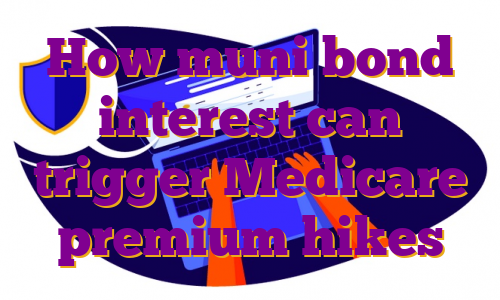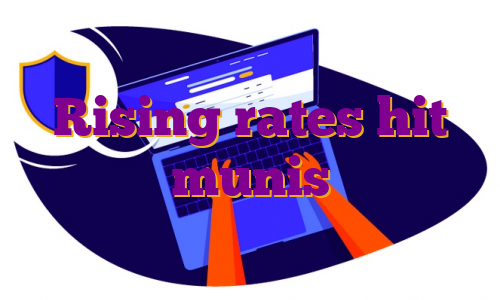Marko Geber | DigitalVision | Getty ImagesAs investors flock to municipal bonds, also known as muni bonds, the tax-free interest may trigger a costly surprise for higher-income retirees.There’s been record demand for U.S. municipal bond funds in 2021, with an estimated $85.36 billion in net inflows through September, according to Refinitiv Lipper data.While demand slid from August through October, investors poured back into muni bonds in November, despite Democrats’ stalled attempts to increase taxes on the wealthy.However, muni bond interest may create a problem for affluent investors: Medicare premium hikes.”There are a lot of moving parts, and you need to have someone look at it holistically,” said Matthew Chancey, certified financial planner at Dempsey Lord Smith in Tampa, Florida.Higher taxes and premiumsAlthough tax-exempt muni bond interest may be appealing, those earnings may increase Social Security taxes and Medicare premiums, said Tracy Sherwood, a Williamsville, New York-based CFP at Sherwood Financial Management. That’s because the formulas for Social Security taxes and Medicare Part B and Medicare Part D use so-called modified adjusted gross income or MAGI, which includes tax-exempt muni bond interest.If half of someone’s Social Security payments plus MAGI is more than $44,000 for a joint tax return ($34,000 for individual filers), up to 85% of their Social Security benefits may be taxable.More from Personal Finance:
Here’s how rising inflation may lead to higher tax bills
Risk-free bond pays 7.12% annual interest for next six months
How to pay 0% capital gains taxes with a six-figure incomeBut with relatively low thresholds, it’s difficult for some higher-income retirees to avoid paying tax on 85% of Social Security payments, Sherwood said. The bigger issue is that retirees with income above certain thresholds may owe a surcharge for Medicare Part B and Part D, known as the Income Related Monthly Adjustment Amount, or IRMAA. The base amount for Medicare Part B premiums in 2022 is $170.10 per month, a 14.5% jump from 2021. However, the payments start to increase for joint filers with MAGI over $182,000 (single filers above $91,000).”That’s where you’re looking at [Medicare Part B] premiums going up by about $70 or more per month,” said Sherwood. “That’s pretty significant.”The top Medicare Part B surcharge is $578.30 for couples filing together with MAGI at $750,000 or above.Retirees may also see premium increases for Medicare Part D, typically covering prescription drugs, with the top surcharge at $77.90 for the highest earners in 2022.Both calculations use MAGI from two years prior, so retirees need to consider the consequences of their income in advance, Sherwood said.”It’s something that taxpayers seem so aware of because if they get into this higher bracket, they have to pay higher premiums for a full year,” said Mary Kay Foss, certified public accountant and CPA faculty at CalCPA Education Foundation in Walnut Creek, California.It’s something that taxpayers seem so aware of because if they get into this higher bracket, they have to pay higher premiums for a full year.Mary Kay FossCPA faculty at CalCPA Education FoundationOf course, added taxes and premiums don’t mean retirees should steer clear of muni bond investing. However, they may consider weighing the pros and cons of tax-exempt interest with a financial advisor. “There’s no such thing as a good or a bad product,” Chancey said. Retirees need to assess each investment in its totality — including risk, yield, growth potential, tax implications, creditor protection and more, he said. “I look at every investment, and I ask myself this question: ‘Is the juice worth the squeeze?'” .
Rising rates hit munis
Municipal-bond investors spent more than a decade fretting about state and local government finances. Now they are worried about interest rates.
Municipal budgets are in far better shape than during the aftermath of the 2007-09 financial crisis or the early-Covid shutdowns when investors fled munis in droves. But the expectation that the Federal Reserve will begin ending pandemic stimulus measures has driven yields on state and local debt, which rise when bond prices fall, to their highest levels since April 2020.
“Credit has just not been the boogeyman that anyone thought it might be,” said Matt Fabian, a partner with Municipal Market Analytics. “The real risk in the sector at least for now is rates.”
Investors seek munis for their stable, often tax-free payments, considered low-risk because they are typically backed by taxes or fees on essential government services. Over the past decade, with yields remaining fairly stable, even a small drop in a town’s credit rating could cause a relatively significant change in the price of its bonds.
Many now consider the prospect of rising rates a more immediate threat, reducing the appeal of outstanding debt by offering better returns on newly issued bonds.
Benchmark 10-year, triple-A general-obligation bonds were trading at 1.65% Friday, according to Refinitiv MMD, up from 1.04% at the start of the year.
The premium investors pay for gold-plated, triple-A rated bonds compared with more speculative triple-B debt has shrunk to 0.7 percentage point from 0.83 percentage point a year ago, according to Refinitiv MMD data for 10-year, general-obligation munis.
The finances of America’s towns, counties and school districts are looking increasingly stable, with governments raking in revenue thanks to federal aid and the stimulus-fueled economic recovery. At the state level, budgets are so flush that officials are topping up state pension funds and giving residents tax rebates.
The bustling economy has served as a rising tide that lifted a range of municipal credits. There were 238 more upgrades of municipal borrowers than downgrades in 2021 by ratings firm S&P Global, not including housing projects. In 2020, there were 676 more downgrades than upgrades. There are now fewer government entities working their way through bankruptcy than at almost any time in the past 10 years, according to Municipal Market Analytics.
Defaults are rare for municipal borrowers, aside from speculative projects like nursing homes that are allowed to issue municipal bonds because they are perceived to have some public benefit. Now postcrisis restructurings by cities like Detroit and San Bernardino, Calif., are in the rearview mirror. Puerto Rico last month emerged from bankruptcy—the largest municipal issuer ever to restructure.
Longer-term threats to municipal finances remain, including climate change, underfunded pension liabilities and population loss in older cities in the Northeast and Midwest. But current risks to the value of bonds issued by states and cities are generally coming from larger market forces, analysts said.
Investors have pulled a net $6.7 billion from municipal-bond funds so far this year, according to Refinitiv Lipper, the most sustained outflows since March and April 2020, when early-pandemic shutdowns left investors panicked that cities and towns would struggle to pay bills. That loss of confidence drove yields on 10-year, tax-exempt, triple-A general-obligation munis to a high of 2.8% on March 23, 2020, when 10-year Treasurys were yielding 0.75%.
Now muni yields are rising alongside Treasury yields as investors try to game out the volatility in global markets and the intentions of world leaders.
“It’s sometimes very hard to read the tea leaves when you’ve got geopolitical risk, Covid, a Fed that is going to be raising rates and inflation that may or may not be transitory,” said Cynthia Clemson, co-director of municipal investments at Eaton Vance Management.
“Municipal credit is in good shape,” Ms. Clemson said. “Everyone’s trying to think ‘What are rates going to do?’”
This story has been published from a wire agency feed without modifications to the text
Subscribe to Mint Newsletters * Enter a valid email * Thank you for subscribing to our newsletter.
Never miss a story! Stay connected and informed with Mint.
Download
our App Now!!
.




